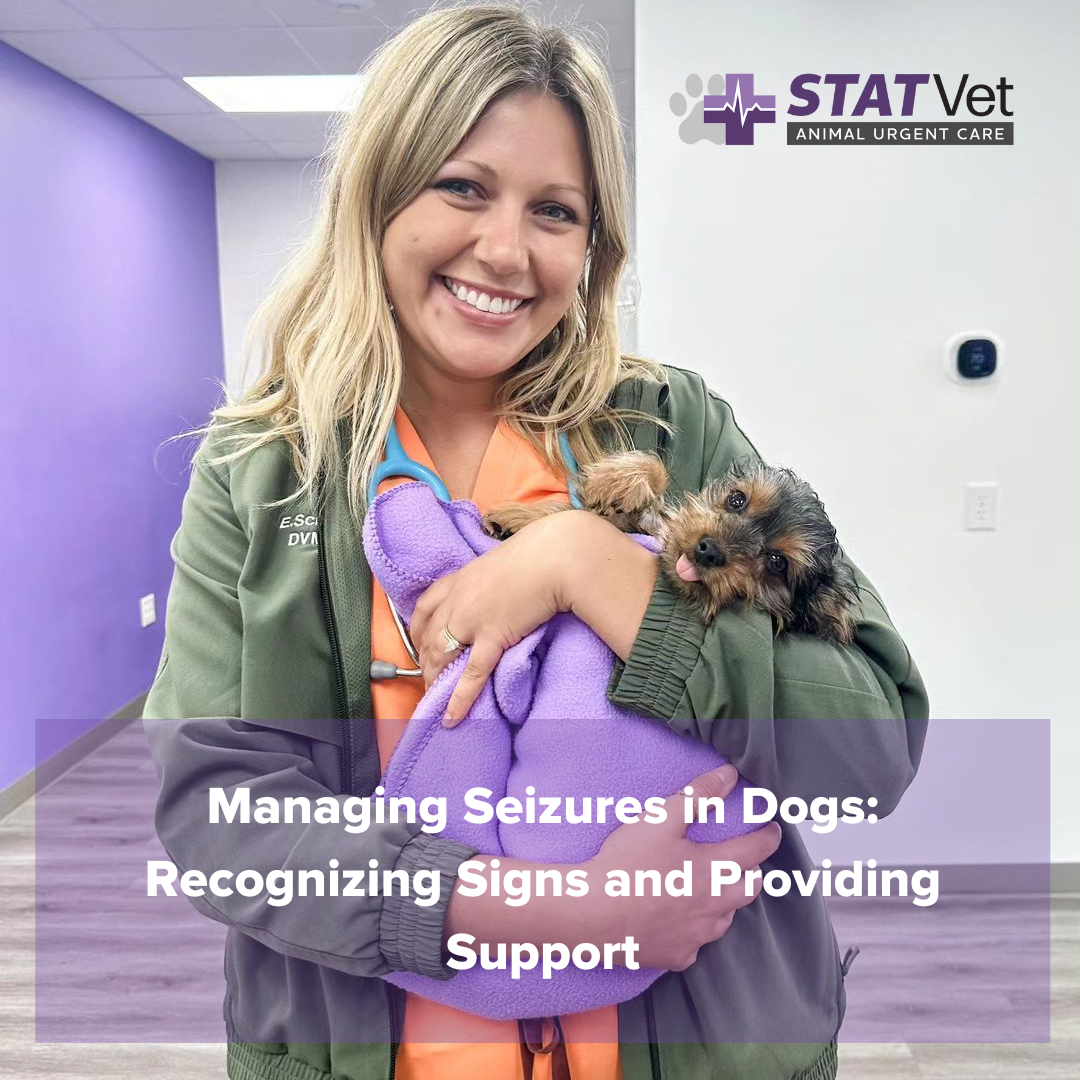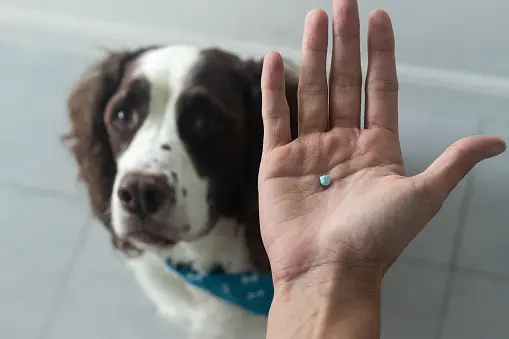
20 May Managing Seizures in Dogs: Recognizing Signs and Providing Support

Owning a dog comes with immense joy and companionship, but it also entails a significant responsibility, especially when it comes to monitoring and maintaining the dog’s health. Proactively managing a dog’s health can decrease the likelihood of health issues and contribute to a longer, happier life for your canine companion. Here are several key aspects to consider:
Regular Veterinary Visits
Regular veterinary visits are crucial for early detection and prevention of health problems. Annual check-ups allow veterinarians to perform routine examinations, administer vaccines, and screen for common diseases. These visits help identify issues such as dental disease, obesity, and early stages of chronic conditions, which might not be immediately apparent to dog owners.
Nutrition and Diet
A balanced diet is essential for a dog’s health. Dogs require a mix of proteins, carbohydrates, fats, vitamins, and minerals to thrive. Commercial dog foods are generally formulated to meet these needs, but choosing high-quality products is important. Some dogs may have special dietary requirements due to age, health conditions, or allergies. Consulting with a veterinarian can help determine the best diet for your dog. Overfeeding or feeding inappropriate foods can lead to obesity, diabetes, and other health issues.
Exercise and Weight Management
Regular exercise is vital for maintaining a dog’s physical and mental health. It helps prevent obesity, a major risk factor for various health problems, including diabetes, arthritis, and heart disease. The amount and type of exercise needed can vary depending on the dog’s breed, age, and health status. Regular walks, playtime, and activities like agility training or swimming can keep your dog fit and mentally stimulated.
Dental Care
Dental health is often overlooked but is crucial for a dog’s overall well-being. Poor dental hygiene can lead to periodontal disease, which can cause pain, tooth loss, and infections that may spread to other parts of the body. Regular brushing of your dog’s teeth, providing dental chews, and professional cleanings can help maintain oral health.
Parasite Prevention
Parasites such as fleas, ticks, and worms can cause significant health issues for dogs. Regular use of preventive treatments, such as topical or oral medications, can protect against these parasites. It’s also important to check your dog regularly for signs of infestation, especially after walks in areas known for ticks or fleas. Heartworm prevention is also crucial, as heartworm disease can be fatal if left untreated.
Monitoring for Signs of Illness
Being vigilant about changes in your dog’s behavior, appetite, and physical condition can help detect health problems early. Symptoms such as lethargy, loss of appetite, vomiting, diarrhea, coughing, or changes in urination and defecation patterns should prompt a visit to the vet. Early detection of illness can lead to more effective treatment and better outcomes.
Grooming and Skin Care
Regular grooming is important for maintaining your dog’s coat and skin health. Brushing helps remove dirt, spread natural oils, and prevent matting. Regular baths with dog-appropriate shampoo can keep the skin clean and reduce the risk of infections. It’s also an opportunity to check for abnormalities such as lumps, rashes, or signs of parasites.
Mental Health and Stimulation
Mental health is as important as physical health. Dogs need mental stimulation to prevent boredom and anxiety, which can lead to destructive behaviors. Providing toys, training, and socialization opportunities can keep your dog mentally engaged. Some dogs may benefit from more structured activities like obedience training or puzzle toys that challenge their problem-solving abilities.
Spaying and Neutering
Spaying or neutering your dog can have significant health benefits. These procedures can prevent certain cancers and reduce the risk of reproductive health issues. They can also help manage behavioral problems related to mating instincts.
Environmental Safety
Creating a safe environment is crucial for preventing injuries and poisoning. Ensure that your home and yard are free of hazards such as toxic plants, chemicals, and small objects that could be swallowed. Safe containment systems, like secure fencing, can prevent accidents and escapes.
Let’s Talk Canine Seizure

Recognizing the signs of a canine seizure and knowing how to respond can be crucial for any dog owner. Dog seizures can be frightening to witness, but understanding what is happening and how to help can make a significant difference in your dog’s health and well-being.
Recognizing the Signs of a Canine Seizure
Seizures in dogs can vary in intensity and duration, but there are common signs to watch for:
1. Pre-ictal Phase (Aura)
– Behavioral Changes: Dogs may exhibit unusual behavior such as restlessness, whining, trembling, or seeking attention.
– Physical Symptoms: Some dogs might salivate excessively, appear disoriented, or seem overly anxious.
2. Ictal Phase (Seizure Itself)
-Loss of Consciousness: During a seizure, dogs often lose consciousness and are unaware of their surroundings.
– Muscle Contractions: Involuntary muscle movements, such as paddling of the legs, stiffening, or jerking motions, are common.
– Vocalization: Dogs might bark, howl, or whimper during a seizure.
– Autonomic Signs: This can include drooling, urination, or defecation.
3. Post-ictal Phase (Recovery)
– Disorientation: After the seizure, dogs may appear confused, disoriented, or unsteady on their feet.
– Temporary Blindness: Some dogs may temporarily lose their vision.
– Exhaustion: It’s common for dogs to be very tired and want to sleep after a seizure.
Types of Seizures
Understanding the type of seizure can also help in recognizing and managing them:
– Generalized Seizures: These involve the entire body and are often more dramatic. They include grand mal seizures, characterized by loss of consciousness and severe muscle contractions.
– Focal Seizures: These affect only a part of the brain and may manifest as twitching or jerking in one part of the body, such as the face or a limb.
– Psychomotor Seizures: These involve unusual behavior that seems purposeless, like chasing invisible objects or biting at the air.
What to Do During a Seizure
1. Stay Calm
– Your calm demeanor can help reassure your dog and allow you to think clearly about what to do next.
2. Time the Seizure
– Note the duration of the seizure. If it lasts more than 2-3 minutes, it can be a medical emergency, and you should contact your veterinarian immediately.
3. Ensure Safety
– Move any objects that could harm your dog away. Ensure they are in a safe space where they cannot fall or injure themselves.
– Do not try to move your dog unless they are in immediate danger.
4. Do Not Touch the Mouth
– Contrary to some myths, dogs will not swallow their tongues. Trying to open their mouths can result in accidental bites.
5. Provide Comfort
– Speak softly and reassuringly to your dog. You can gently pet them once the seizure activity has ceased.
What to Do After a Seizure
1. Allow Recovery Time
– Let your dog rest in a quiet, comfortable space. They will likely be disoriented and tired.
2. Monitor Behavior
Observe your dog for any additional seizures or unusual behavior. Note any changes, as this information can be valuable for your veterinarian.
3. Contact Your Veterinarian
– Report the seizure to your vet, even if it’s a single occurrence. They may recommend an examination or further tests to determine the cause.
Long-Term Management and Prevention
1. Medical Evaluation
– If your dog has recurrent seizures, a thorough medical evaluation is necessary to identify the underlying cause. This may include blood tests, neurological exams, and imaging studies like MRI or CT scans.
2. Medication
– Depending on the frequency and severity of the seizures, your veterinarian may prescribe anticonvulsant medications. It’s important to follow the medication regimen closely and report any side effects.
3. Lifestyle Adjustments
– Minimize stress and maintain a consistent routine for your dog. Regular exercise and a balanced diet can also contribute to overall health and potentially reduce seizure occurrences.
4. Avoid Triggers
– Identify and avoid potential seizure triggers. These can include certain foods, environmental changes, or specific activities.
Supportive Care
1. Diet and Supplements
– Some diets, particularly those rich in medium-chain triglycerides (MCTs), have been shown to reduce seizure frequency in some dogs. Supplements like omega-3 fatty acids may also be beneficial.
2. Alternative Therapies
– Acupuncture, CBD oil, and other alternative treatments can sometimes help manage seizures. Always consult your veterinarian before starting any new therapy.
3. Emergency Preparedness
– Have an emergency plan in place. Keep your veterinarian’s contact information handy, and know the location of the nearest emergency veterinary clinic.

Conclusion
Recognizing the signs of a canine seizure and knowing how to respond effectively can help mitigate the impact on your dog’s health. You can provide crucial support during and after seizures by staying calm, ensuring safety, and seeking veterinary care. Long-term management, including medical evaluation, medication, and lifestyle adjustments, can help reduce the frequency and severity of seizures, ensuring your dog enjoys a better quality of life.

